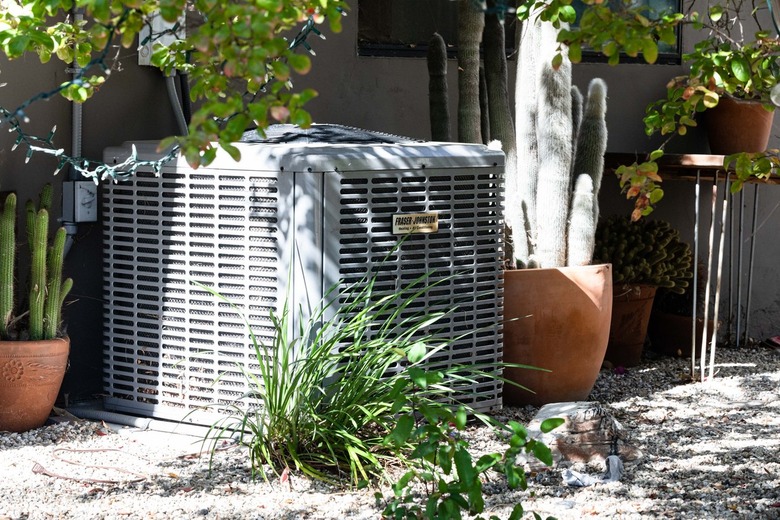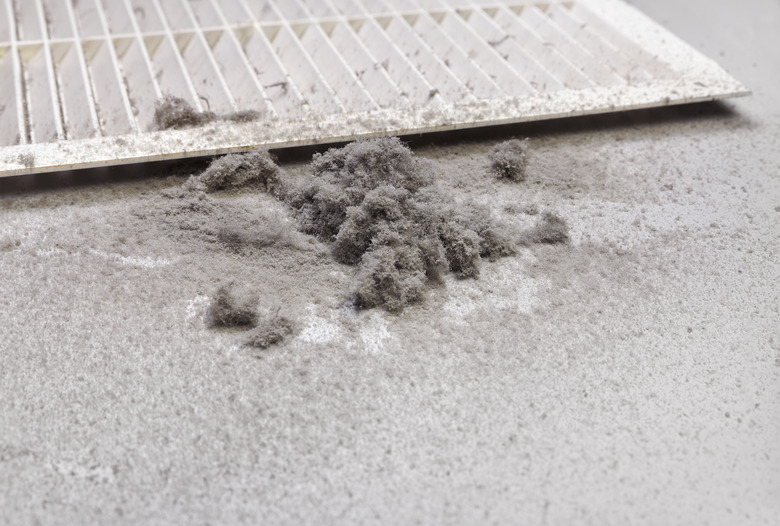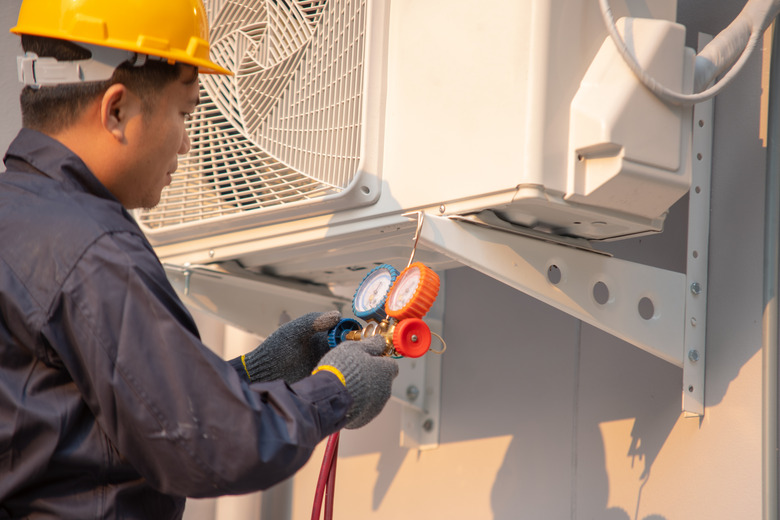Essential Air Conditioner Maintenance You Can Do Yourself
We may receive a commission on purchases made from links.
A central air conditioner can last for 15 to 20 years, and your A/C unit is more likely to hit the upper limit of this range and even exceed it if it gets the proper TLC. Many of the maintenance tips recommended by HVAC pros apply equally to central air conditioning units, wall and window units, and ductless minisplit systems, but central units have ductwork that should also be part of your maintenance regimen. Not every A/C maintenance procedure is DIY-friendly, but some of the most important ones are, and none of them are particularly time-consuming.
Efficient cooling depends on good airflow, so unless you're an air conditioner maintenance newbie, you probably know where this is going. It's essential to change filters regularly and to keep the working parts of the system clean, and there are tools that make this easier. It's also important to watch for moisture problems within the system and address them promptly to avoid circulating mold through your house along with the cool air. Besides these essential tasks, there are a few other less common A/C maintenance tasks you may need to perform from time to time but only if they are needed.
Understand the Operation of Your Air Conditioner
Understand the Operation of Your Air Conditioner
If your house has central air conditioning, you have a split system — meaning part of the air conditioner is in a housing situated outside the house and part is indoors — and both parts need maintenance.
The outdoor unit contains the condenser (or compressor) — which is similar to the condenser in your refrigerator — and the condenser coils, which get hot when the unit is running. The reason these coils get hot is because the condenser is pressurizing the refrigerant circulating in the system and turning it from a gas into a liquid. In scientific terms, this is an exothermic process, or one that releases heat. It's important to maintain good air circulation in the outdoor unit so that this heat can dissipate; otherwise, the condenser may overheat and stop working.
The indoor part of a central air conditioner consists of a coil in which the pressurized refrigerant is allowed to dissipate and turn into a gas, which is an endothermic process that draws heat from the surrounding air. This is the evaporator coil, and it's housed inside an air handler, which looks like a furnace and may even be part of an HVAC system that includes a furnace. Inside the air handler is a blower to circulate the cooled air throughout the system ductwork, which is attached to it. It's just as important to maintain good airflow through the air handler as it is through the compressor housing.
Top of the List: Read Your Manual
Top of the List: Read Your Manual
Many homeowners neglect to consult their owner's manual, so this is one of the most important A/C maintenance tips, on par with familiarizing yourself with your car's owner's manual so you know what all the flashing lights on the dashboard mean. Among the things the manual will tell you are the type and size of air filters you need and the meanings of error codes. If you don't have the manual that came with the unit, which is likely if you have an older one, you can usually find the information you need on the manufacturer's website, often including an electronic version of the manual for your model.
Next Step: Keep the Air Circulating
Next Step: Keep the Air Circulating
The outdoor unit draws air through an air filter and expels it through a grid consisting of thin metal fins that absorb the heat from the condenser coils and radiate it into the atmosphere. Homeowners should check the filter once a month while the system is operating and either clean it (if it's cleanable) or replace it. Filters are inexpensive, so if you have to replace one, it won't make a very big dent in your bank account, and it's worth it to keep the condenser operating smoothly and avoid expensive repairs down the road.
While checking the filter, you should also check the metal fins on the wall of the housing. If they are dusty, brush off the dust with a soft brush (a coil brush used for cleaning dust off the coils will work), and if they are blocked by gummy deposits, remove the deposits with a kitchen knife, which you can also use to straighten any of them that are bent, or brush down the coils with soap and water from a garden hose. You can also use a handy tool called a fin comb to clean and straighten the fins, but be sure to wear gloves because the fins are sharp.
The air filter in the indoor unit is usually located at the base of the air handler, and it needs to be cleaned or replaced monthly. If you neglect this task and the filter clogs up, the lack of airflow may cause ice to form on the evaporator coil, and you may have to turn off the system for a day or two to give the ice time to melt. You should never try to break up the ice with a sharp or hard object because the coil is fragile, and you can easily damage it.
Clean Off Dust and Condensation
Clean Off Dust and Condensation
Despite the air filters, dust is bound to make it inside the condenser unit and the air handler and collect on the coils and moving parts, such as the blower blades. Before cleaning off this buildup, be sure to turn off the power. The best way to do this is to flip off the circuit breaker in the main panel that controls the A/C system. Use a coil brush or some other soft brush to brush down both sets of coils and any other components that have gotten dusty, including the blower blades, blower motor, and condenser.
This isn't a job you have to do as often as cleaning the filters, but you should do it at least once during every cooling season. Dust buildup can hamper heat exchange through the coils, reduce the energy efficiency of the cooling system, and drive up your energy bills.
It's also important to remove the vent covers around the house and clean the vent openings. Because there's a temperature differential between the inside and outside of the ducts, condensation can form, and where there's moisture, there is usually mold. Wipe down the inside of the ducts with a dry cloth to prevent mold from growing and circulating through the house.
Check and Clean the Condensate Drain
Check and Clean the Condensate Drain
Warm air can hold more moisture than cold air, so as the air around the evaporator coil cools, water condenses out, collects on the coils, and eventually drips onto the base of the air handler. There's a drain pan there to collect it, and tubing connected to the pan directs water outside. It's important to check this drain line periodically to ensure it isn't blocked because if it is, water will collect in the pan, which creates two possible problems: The pan could overflow and spill onto the floor, and the standing water could promote mold that gets circulated into the house.
You can usually clear a clogged drain with household vinegar, which is safer than bleach and will also disinfect it and kill any mold that may have started growing. Most central A/C unit drain lines have a vent tee rising up along the side of the air handler, and this is a good place to pour the vinegar after you've powered down the system and blocked the outlet to keep the vinegar inside the tubing long enough to do its job. Uncap the tee, pour in the vinegar full strength, and give it at least 30 minutes to work before unplugging the outlet, flushing the pipe with water, and turning the system back on.
Prepare for Winter the Right Way
Prepare for Winter the Right Way
Unless you have a heat pump that is used for both cooling and heating, you'll want to protect your outdoor unit from the elements during the winter months. The best way to do this is to place a sheet of plywood that's just large enough to cover it completely on top of the housing and hold it down with bricks or stones. This allows the unit to breathe and prevents mold from growing.
This is a better way to protect the outdoor unit than wrapping a tarp around it because condensation is bound to form under the tarp. The combination of moisture and lack of air circulation provides ideal conditions for mold, especially on warm, sunny days when the temperature under the tarp can be as high as it is during the summer.
Check the Level of the Outdoor Unit
Check the Level of the Outdoor Unit
The outdoor unit is typically mounted on a concrete pad, and it isn't unusual for the pad to sink partially into the ground as the years go by. To operate at full capacity, the condenser has to be level, so it's important to check periodically and make adjustments if necessary. While you're going to need professional help to unhook the condenser and repair the pad if it has seriously degraded, most homeowners can take care of minor leveling problems themselves.
Put a level on the top of the housing and check whether the bubble is centered. If it isn't and there's no stress on the tubing connected to the unit, drive a few wooden or plastic shims under the feet of the unit where needed to bring the bubble to center. Don't forget to level in both directions.
When You Need a Pro
When You Need a Pro
If you notice an uptick in your energy bills, the refrigerant levels in your A/C system may be low. This may be due to a leak, or the system may simply need recharging, but either way, you need a licensed pro to work on any problem that involves disassembling the refrigeration system or adding refrigerant. It's not that some skilled DIY homeowners couldn't do this themselves; it's a matter of law. Refrigeration service is tightly controlled to prevent the inadvertent release of refrigerant into the atmosphere, even though modern refrigerants are far less damaging than R-22 (or Freon), the phase-out of which was completed in 2020.
You'll also need a pro to service electrical connections inside the system and from the thermostat to the main control panel. To make sure all this remains in good working order, it's a good idea to schedule a service checkup and tune-up at least once a year. Besides checking all the circuitry, an HVAC pro will also clean parts of the system you can't access yourself as well as test the ductwork for leaks and make necessary repairs. If you have an older system that uses Freon, it's time for a new one, and a pro will be able to recommend a suitable replacement.
One problem for which you should definitely call a pro is when the condenser short-cycles, which means it turns off and on in short time intervals (15 minutes or so). This puts undue stress on the condenser and shortens its service life, and it can happen if the system is too large for your house, but there are many other possible causes. A professional consultation will help you decide whether to spend money on A/C repair or whether you need to replace your air conditioning system.
References
- A/C Designs: Air Conditioner Maintenance – The Ultimate Homeowners Guide 2021
- A+ Air Conditioning & Refrigeration, Inc: How to Clean Your AC Condensate Drain Line With Vinegar
- Energy.gov: Maintaining Your Air Conditioner
- Four Seasons Heating, Air Conditioning, Plumbing, Electric: 4 Signs It's Time to Replace Your Air Conditioner
- Lennox: Air Conditioner Maintenance Tips


